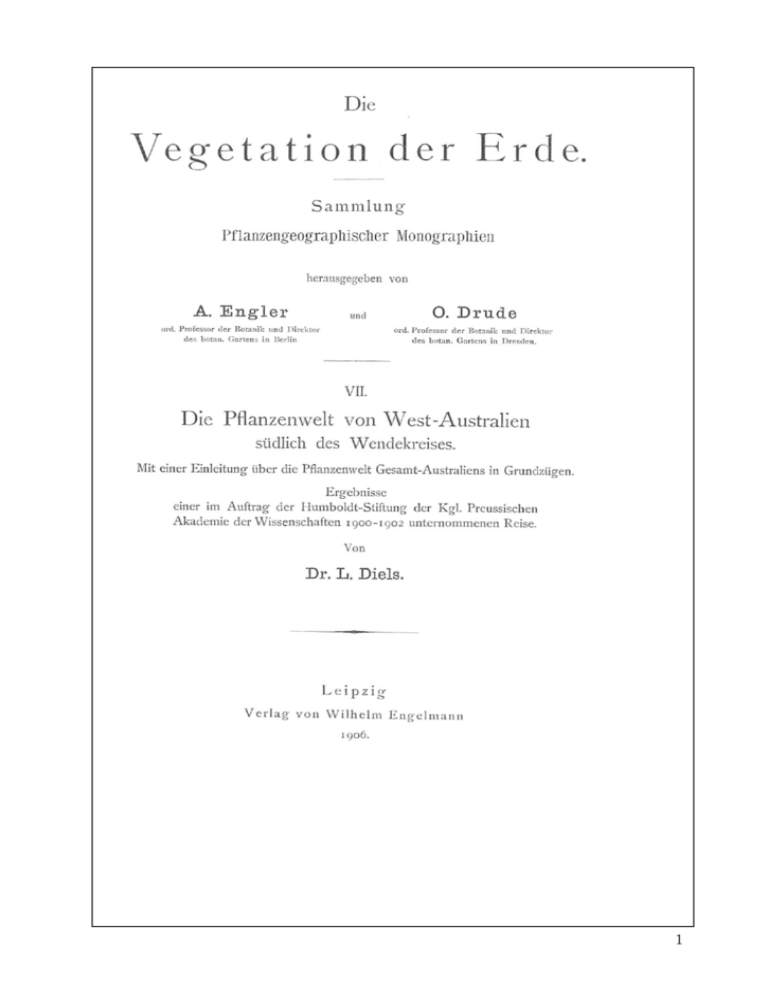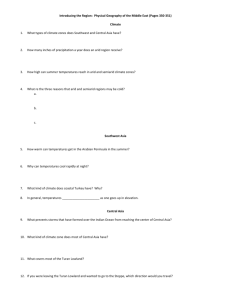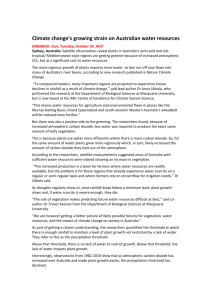
The
Vegetation of the World
A series of
Plant Geographical Monographs
Edited by
A. ENGLER
Professor of Botany Director of the Botanic
Gardens in Berlin
and
O. DRUDE
Professor of Botany
Director of the Botanic
Gardens in Dresden
VII
The Plant Life of
Western Australia south of the tropics
With an Introductory Part dealing with the salient features
of the vegetation of the whole of Australia
The results of an expedition carried out during 1900-1902
under the auspices of the Humboldt Foundation
Royal Prussian Academy of Science
by
Dr. L. DIELS
LEIPZIG
Published by Wilhelm Engelmann
1906
The
Plant Life of
Western Australia
south of the Tropic with an
Introductory Part dealing with the salient features of the
Vegetation of the whole of Australia
The results of an expedition undertaken during 1901-1902
under the auspices of the Humboldt Foundation
Royal Prussian Academy of Science
Dr. L. Diels
Lecturer at the University of Berlin
Assistant at the Royal Botanical Museum
With 1 vegetation map and 82 text figures, together with
34 original photographic plates taken by Dr. E. Pritzel
Leipzig
Published by Wilhelm Engelmann
1906
A translation by
Emeritus Professor B.J. GRIEVE, Professor B.B. LAMONT
and Dr E.O. Hellmuth
Edited Dr N. Gibson
Acknowledgments
The publication of the translation of this classic work was assisted by generous
grants from the Utah Foundation in Brisbane, and the German Government in
Bonn through Agencie Internationale to B.J. Grieve.
Special thanks are due to: K. Holland who typed the whole of the original manuscript as completed by BJ Grieve in 1950 and the revisions of 1990/91; the School
of Plant Biology, University of Western Australia for the curation of Prof. Grieve’s
manuscript and notes over many years; L. Cobb and the Wildflower Society of
Western Australia for facilitating access to these materials which has allowed the
publication of this long delayed work.
The copyright to the original 1906 publication and the 1976 facsimile is held by
J. Cramer in Gebrüder Borntraeger Verlagsbuchhandlung
http:/www.schweizerbart.de
mail@schweizerbart.de
who kindly gave permission for the publication of this translation.
All rights reserved.
Perth 2007
v 1.04
AUTHOR’S PREFACE
Knowledge of the plant life of Western Australia was very limited at the time of my visit. While
the floral elements were well known, no studies had been made on their inter-relationships in the
field. Again, although their external affinities had been noted by Hooker, little was known about
the conditions that determined the inner relationships of the endemic flora. These aspects were
considered as being fundamentally important. Because of the variation in form of its vegetation
and the fact that this variation occurred in a winter rainfall area of the earth (where the vegetation
is more closely defined and shows a more regular gradation than in any other part) it appeared
that it might provide solutions to many questions of general interest. Also the country’s unrivalled
richness in species could be expected to prove rewarding to those who studied its vegetation.
For these reasons I proposed a study visit there and in 1900 submitted my plan to the governors
of the Humboldt-Foundation for Biological Research and Travel. The account of the vegetation
formations of Western Australia and the investigation of the conditions influencing the development of the wide range of species existing in the flora were considered to be the most important
matters to be investigated.
The governors of the Humboldt-Foundation approved my plan and I was able to travel to Australia and engage on a two-year research programme. Fourteen months were allocated for studies
in Western Australia.
The taxonomic results which formed the first part of my researches have already been published
in collaboration with Dr E. Pritzel (L. Diels and E. Pritzel, Fragmenta Phytographiae Australiae
occidentalis. In Englers Botan. Jahrbüchern XXXV [1904, 1905]). The second part, which deals
with the plant geography and botany of the area, represents the fulfillment of the main objective
of my expedition.
I am most grateful to those who financed my research work. The Royal Prussian Academy in
Berlin and the governors of the Humboldt-Foundation have, through the funds provided by the
latter, enabled me not only to travel extensively in the area which formed the main subject of my
researches, but also to become more familiar with the problems facing me by providing me with
the opportunity to visit the Cape region [South Africa] and eastern Australia. I wish to thank the
authorities for their munificence and in particular the President of the Governors, Medical Privy
Councillor, Professor Waldeyer, for his constant sympathetic support.
I am deeply indebted also to the Government of Western Australia, which greatly assisted me.
I wish particularly to express my most sincere gratitude to the Rt. Hon. Sir John Forrest, P.C.,
G.C.M.G., at that time Premier of the State, for his active interest which contributed significantly
to making my visit so successful.
I was accompanied by Dr E. Pritzel during the tour and I wish also to thank him for his great
help during our travels. He placed at my disposal all the photographs he took during the trip,
and also assisted in proof-reading the manuscript.
Finally, I must thank Privy Councillor Professor Engler, my esteemed teacher, for advice during the preparation of this volume. It was, for instance, at his suggestion that the introductory
section dealing with the vegetation of the whole of Australia was presented. This was designed to
serve as a setting for the picture of the botany of the more restricted area of Western Australia
and to help to highlight the features that give that region its greatest individuality.
BERLIN, May 1906
L. DIELS
CONTENTS
INTRODUCTION
The characteristic features of the vegetation of Australia
I.
II.
General Physiography15
Formations:-16
1. Tropical rainforest16
2. Subtropical rainforest19
3. Sclerophyll forests and woodland20
4. Savanna woodland22
5. Riparian woodlands24
6. Coastal woodlands and scrubs25
7. Savanna26
8. Shrublands27
a. Mallee scrub27
b. Sublittoral sclerophyll shrubland29
c. Sand heaths29
d. Mulga scrub30
e. Brigalow scrub30
9.
Deserts31
Schematic Explanation of the Vegetation Map32
III.
Regions32
Bellenden-Ker Range32
Southeastern Mountains33
IV.
Floristics36
1.
Elements of the Australian Flora36
a. Antarctic element36
b. Malaysian element36
c. Australian element39
2.
Regional Distribution of the Australian Flora40
a. Eastern Australia40
b. Eremaea41
c. Southwest Australia42
PART I
History and literature of the botanical investigation of extra-tropical Western
Australia
Chapter 1
History
43
Early discoveries43
The French43
Robert Brown and his contemporaries45
Baron von Hügel46
Preiss47
James Drummond and his contemporaries48
Ferdinand von Müller and his correspondents52
Spencer Le Moore56
57
Diels and Pritzel
Current endeavors59
Chapter 2.
Literature
60
PART II
An outline of the Physical Geography of extra-tropical Western Australia
Chapter 1.
Chapter 2.
Chapter 3
General Geography I.
Physical Geography
II.
Geology
Climate
I.
Rainfall
II.
Temperature
III.
Evaporation
IV.
Yearly weather cycle
Subdivision based on geographic character & vegetation
65
65
66
69
69
72
73
74
75
PART III
The Vegetation of the Southwest Province
Chapter 1.
Chapter 2.
General Character
77
Physiognomically Important Plants
78
I.
The Eucalypts
78
1. Eucalyptus marginata - Jarrah
80
2. Eucalyptus calophylla - Red Gum
82
3. Eucalyptus diversicolor - Karri
82
4. Eucalyptus gomphocephala - Tuart
85
5. Eucalyptus redunca -Wandoo
87
II. The genus Casuarina 87
III. The species of Banksia (Prot.)
90
IV. Nuytsia floribunda (Loranth.)
94
V. Macrozamia Fraseri
98
VI. Tree-like Liliaceae
98
Chapter 3.
The Characteristic Families and their Lifeforms
105
1. Proteaceae105
2. Myrtaceae107
3. Leguminosae - Podalyrieae110
4. Acacia
113
5. Epacridaceae114
6. Goodeniaceae117
7. Cyperaceae118
8. Liliaceae118
9. Stylidiaceae119
10. Orchidaceae120
11. Sterculiaceae122
12. Restionaceae122
13. Rutaceae126
14. Umbelliferae126
15. Amaryllidaceae - Conostylideae127
16. Hibbertia
130
17. Drosera
131
18. Centrolepidaceae131
19. Cassytha
131
20. Families also common in the Eremaea133
21. Families under represented in the Southwest Province134
Chapter 4.
Ecological Character
135
a.
Lifeforms of the vegetation135
b. Forms of Branching141
c.
Stems144
c. Stems 144
d. Leaves 144
e. Flowers155
f. Adaptation and morphology160
g. Yearly vegetation cycle165
Chapter 5.
Formations
173
a. Littoral Formations173
a. Mangrove173
b. Mudflat formation
173
c.
Open formation of the sandy beaches173
d. Littoral woodland174
1. The Northern Zone174
2. The Tuart Zone177
3. The Southern Zone178
b. Woodland Formations180
a. Eucalyptus forest and woodland180
1. Jarrah forest181
2. Karri forest184
3. Wandoo woodland186
4. Transition to the woodlands of the Eremaea188
b. Mixed woodlands of the coastal plain191
c.
Shrubland Formations196
a. Sclerophyll scrub196
b. Sand heaths204
d. Swamp Formations214
a.
Alluvial formation214
b.
Formation of the granite rocks224
PART IV
The Vegetation of the Eremaean Province
Chapter 1.
General Character
225
Chapter 2.
Physiognomically Important Plants
226
I. The Eucalypts226
1. Eucalyptus rostrata 226
2. The true Eremaean eucalypts228
II. The species of Acacia
230
III. Callitris robusta
232
IV. Codonocarpus cotinifolius
235
Chapter 3.
The Characteristic Families and their Lifeforms
236
1. Compositae236
2. Chenopodiaceae238
3. Myoporaceae238
4. Gramineae240
5. Verbenaceae241
6. Amaranthaceae242
7 Dodonaea
243
8. Santalaceae245
Chapter 4.
Chapter 5.
Ecological Character
246
a. Lifeforms 246
b. Forms of Branching246
c. Stems246
d. Leaves248
e. Flowers250
f. Yearly Vegetation Cycle250
Formations
252
a.
Littoral formations252
a. Mangrove and mudflat formations
252
b. Formations of the sandy beaches and dune scrub253
b. Woodland Formations255
a. Eucalypt woodlands of the Eremaea255
b. Savanna woodlands 259
c. Shrubland Formation of the Eremaea267
a. Mulga formation of the north267
b. Bush formation on sand270
d. Halophytic formations of the salt-pans271
PART V
The Flora of extra-tropical Western Australia and its Classification
Chapter 1.
FIoristic Subdivision of the Region
273
a. The Southwest Province274
1. The Irwin District274
2. The Avon District277
3. The Darling District279
4. The Warren District281
5. The Stirling District283
6. The Eyre District288
b. The Eremaean Province290
7. The Coolgardie District290
8. The Austin District292
Chapter 2.
Elements of the Flora of Western Australia
293
1. Southwest Province293
a. Pan-Australian elements293
1. Pan-Australian species293
2. Types of the Eremaea 294
3. Pan-Australian elements of higher rank 294
4. Character of Pan-Australian genera in WA297
b. Disjunct elements
299
I. North eastern types299
II. South eastern types301
1. Northern subdivision301
2. General southeastern subdivision302
3. Southern subdivision304
c. Endemic elements305
1. Endemics 1 order305
2. Endemics 2 order307
3. Endemics of the last order308
d. Naturalised colonists311
II. Eremaean Province 311
a. Northern elements312
b. Autochthonous elements312
c. Intrusion of Eremaean elements into SW Province313
10
Chapter 3.
Chapter 4.
Map
Floristic Relationships with Other Regions 315
a. Relationships with other parts of the earth, esp. the Cape 315
b. Relationships within Australia 317
a. Eremaean Province318
b. Southwest Province319
1. Relationship with the Eremaea321
2. Relationship to southeast Australia322
The Evolution of the Flora of extra-tropical WA
325
Vegetation of Australia 1: 27,000,000328
APPENDICES
Additional information
Appendix
Appendix
Appendix
Appendix
A
B
C
D
Taxonomy update329
Figure caption translations344
Plate caption translations356
Lamont & Grieve: Comparative photographs360
11
Directory of the Plates
I, II, III, IV, V, VI, VII, VIII, IX, X, XI, XII, XIII,
XIV,
XV, XVI, XVII, XVIII,
XIX, XX, XXI, XXII, XXIII,
XXIV,
XXV,
XXVI,
XXVII,
XXVIII,
XXIX,
XXX,
XXXI,
XXXII,
XXXIII,
XXXIV,
12
see p. 79.
see p. 81.
see p. 83.
see p. 86.
see p. 91.
see p. 95.
see p. 99.
see p. 101.
see p. 103.
see p. 175.
see p. 179.
see p. 185.
see p. 189.
see p. 193.
see p. 195.
see p. 197.
see p. 199.
see p. 201.
see p. 207.
see p. 209.
see p. 213.
see p. 217.
see p. 223.
see p. 227.
see p. 229.
see p. 231.
see p. 233.
see p. 254.
see p. 258.
see p. 260.
see p. 262.
see p. 264.
see p. 266.
see p. 268.
Eucalyptus marginata Sm.
Eucalyptus calophyl1a R. Br.
Eucalyptus diversicolor F.v.M.
Eucalyptus gomphocephala DC.
Banksia attenuata R. Br.
Nuytsia floribunda R. Br.
Macrozamia Fraseri Miq.
Tree-like Liliaceae.
Dasypogon Hookeri Drumm.
Mangrove and mudflat.
Coastal woodland. Tuart-Zone.
Edge of woodland in Warren District.
Wandoo woodland: Eucalyptus redunca Schau.
Mixed woodland of sandy coastal plain.
Mixed woodland of sandy coastal plain.
Very open woodland of the sandy coastal plain
Shrubland formation.
Sclerophyll bush in the western Stirling Range.
Edge Sand heath.
Scrub heath on sand
Edge of Scrub heath on sand.
Alluvial formation.
Vegetation of the granite rocks.
Eucalyptus loxophleba Benth.
Eucalyptus occidentalis Endl.
Eucalyptus salmonophloia F.v.M.
Acacia acuminata Benth.
Eucalyptus woodland in the Eremaea.
Eucalyptus stand of the eremaean savanna type.
Savanna woodland.
Typical savanna of the Acacia type.
Creek vegetation in the transitional zone.
Mulga formation of the Eremaea.
Eremaean landscape with Helipterum splendidum Hemsl.
Directory of the Text Figures
1. Status of the floristic research in 1905 60
2. Distribution of precipitation 69
3. Eucalyptus marginata Sm. 80
4. Eucalyptus diversicolor F. v. M. 84
5. Eucalyptus gomphocephala DC 85
6. Eucalyptus redunca Schau. 88
7. Casuarina glauca Miq. 89
8. Banksia grandis R. Br. 93
9. Nuytsia floribunda R. Br. 97
10. Xanthorrhoea, Kingia, Dasypogon 104
11. Petrophila ericifolia R. Br. 106
12. Hakea dolichostyla Diels 107
13. Melaleuca Preissiana Schau. 108
14. Myrtaceae of the Southwest Province 109
15. Verticordia Pritzelii Diels. 110
16. Podalyrieae of the Southwest Province 111
17. Oxylobium species 112
18. Acacia species of the Southwest Province. 115
19. Leucopogon species of the Southwest Province 116
20. Goodeniaceae of the Southwest Province 117
21. Borya nitida Labill. 119
22. Stylidium species of the Southwest Province 121
23. Orchidaceae of the Southwest Province 123
24. Sterculiaceae of the Southwest Province 124
25. Restionaceae of the Southwest Province 125
26. Boronia species. 127
27. Umbelliferae of the Southwest Province128
28. Conostylis species 129
29. Hibbertia hypericoides (DC.) Benth. 130
30. Droseraceae of the Southwest Province132
31. Centrolepidaceae of the Southwest Province 133
32. Drosera species with bud protection 137
33. Calandrinia with tubers 138
34. Bulbous plants 138
35. Annuals 139
36. Hygrophilic Composites140
37. Pattern of the branching 141
38. Grevillea with long and short shoots 142
39. Cushion form of Scaevola humifusa De Vr. 143
40. Development stages of the branch point with Acacia barbinervis Benth. 145
41. Flower types of the Rhamnaceae 148
42. Hakea Brookeana F. v. M. 150
43. Aphyllous species: Psammomoya 151
44. Acacia insolita E. Pritzel 152
45. Typical form of the leaf cross section 153
46. Anatomy of the leaf of Xerophytes 156
47. Bud scales of the flowers 157
48. Corolla-like bracts as involucres 158
49. Adaptations of leaves in Logania Sect. Eulogania 162
50. Adaptations of leaves in Logania Sect. Stomandra164
51. Adaptations of leaves in Dryandra 166
52. Adaptive convergence 167
53. Everlasting Composites of the Southwest Province 190
54. Pentaptilon Careyi (F. v. M.) E. Pritzel 211
55. Stylidium repens R. Br. 212
56. Melaleuca Preissiana Schau. 219
57. Levenhookia 220
13
58.
59.
60.
61.
62.
63.
64.
65.
66.
67.
68.
69.
70.
71.
72.
73.
74.
75.
76.
77.
78.
79.
80.
81.
82.
14
Annuals the herblands 221
Eucalypts of the Eremaea 230
Acacia aestivalis E. Pritzel 234
Callitris robusta R. Br 235
Angiantheae 237
Eremophila 239
Triraphis rigidissima Pilger 241
Verbenaceae of the Eremaea 242
Dodonaea 243
Characteristic Santalaceae of the Eremaea 244
Exocarpus 244
Verbenaceae of the Eremaea, Newcastlia. 247
Eremophila 249
Trichinium exaltatum (Nees) Benth. 256
Floristic arrangement in eight districts275
Dryandra Fraseri R. Br. 276
Sphenotoma Drummondii Benth. 286
Verticordia 300
Distribution of Jacksonia 302
Distribution of Banksia303
Distribution of Drosera Sect. Erythrorrhiza 304
Eremosyne pectinata Endl. 306
Cephalotus follicularis Labill. 309
Diplolaena grandiflora Desf. 310
Geleznovia verrucosa Turcz. 311







